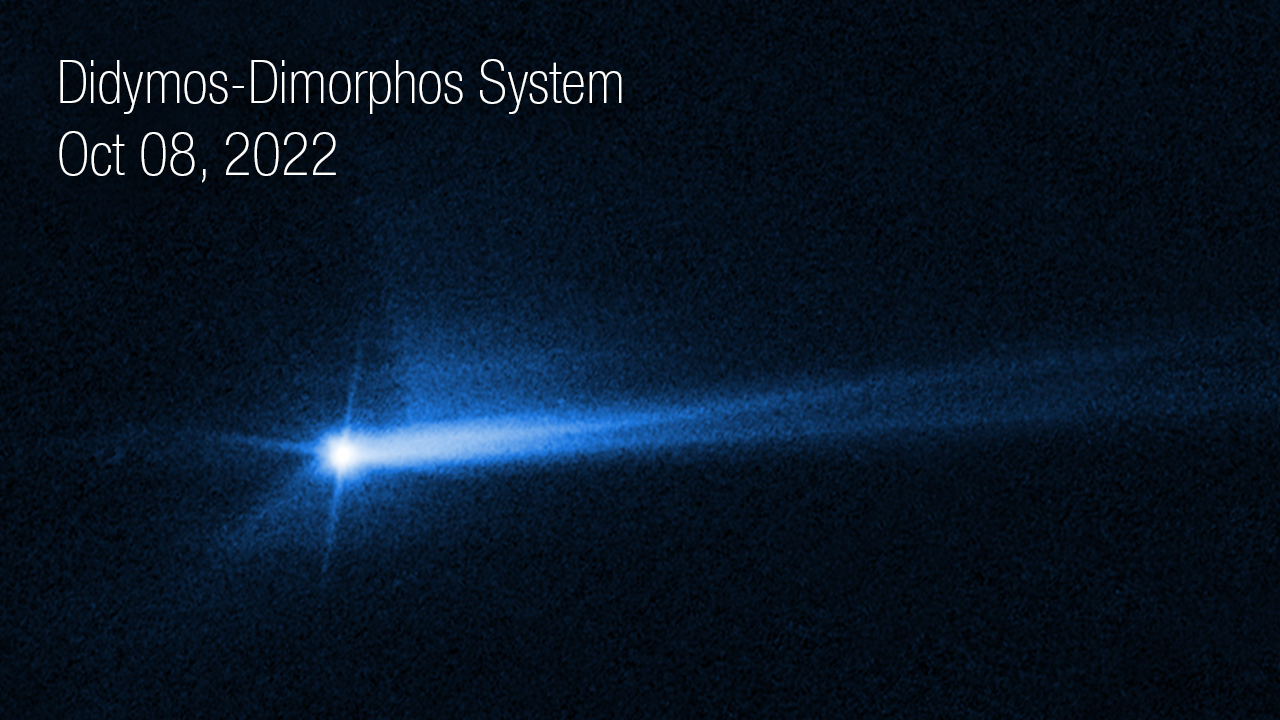1 min read
Didymos-Dimorphos System on October 11 (Compass)

Two tails of dust ejected from the Didymos-Dimorphos asteroid system are seen in new images from NASA’s Hubble Space Telescope, documenting the lingering aftermath of the NASA’s Double Asteroid Redirection Test (DART) impact.
At the top right of the image, there are arrows indicating the direction of impact by the DART spacecraft. The direction of impact arrow points in the 10 o’clock direction. The ‘to Sun’ arrow points in the 8 o’clock direction.
Following impact, Hubble made 18 observations of the system. Imagery indicates the second tail formed between Oct. 2 and Oct. 8.
At the bottom right are compass arrows indicating the orientation of the image on the sky. The north arrow points in the directly straight up. The east arrow points to the left in the 9 o’clock direction. In the top left corner of each image are the filters used to create the image. For Hubble, F350LP is blue.
About the Data
- Data DescriptionData DescriptionProposal: A description of the observations, their scientific justification, and the links to the data available in the science archive.
Science Team: The astronomers who planned the observations and analyzed the data. "PI" refers to the Principal Investigator.This image was created from HST data from proposal: 16674 (J. Li).
- InstrumentInstrumentThe science instrument used to produce the data.WFC3/UVIS
- Exposure DatesExposure DatesThe date(s) that the telescope made its observations and the total exposure time.11 Oct 2022
- FiltersFiltersThe camera filters that were used in the science observations.F350LP
- Object NameObject NameA name or catalog number that astronomers use to identify an astronomical object.Didymos-Dimorphos System
- Object DescriptionObject DescriptionThe type of astronomical object.Double Asteroid Redirection Test (DART) on asteroid Dimorphos
- Release DateOctober 20, 2022
- Science ReleaseNASA’s Hubble Spots Twin Tails in New Image After DART Impact
- CreditNASA, ESA, STScI, Jian-Yang Li (PSI); Image Processing: Joseph DePasquale

The images are separate exposures acquired by the WFC3 instrument on the Hubble Space Telescope. The color results from assigning a blue hue to a monochromatic (grayscale) image.
Related Images & Videos

Didymos-Dimorphos System on October 11
Two tails of dust ejected from the Didymos-Dimorphos asteroid system are seen in new images from NASA’s Hubble Space Telescope, documenting the lingering aftermath of the NASA’s Double Asteroid Redirection Test (DART) impact. The DART spacecraft impacted Dimorphos, a small...

Didymos-Dimorphos System on Oct 8 and 11, 2022
Two tails of dust ejected from the Didymos-Dimorphos asteroid system are seen in new images from NASA’s Hubble Space Telescope, documenting the lingering aftermath of the NASA’s Double Asteroid Redirection Test (DART) impact. This video shows a progression of the...
Share
Details
Claire Andreoli
NASA’s Goddard Space Flight Center
Greenbelt, Maryland
claire.andreoli@nasa.gov




























